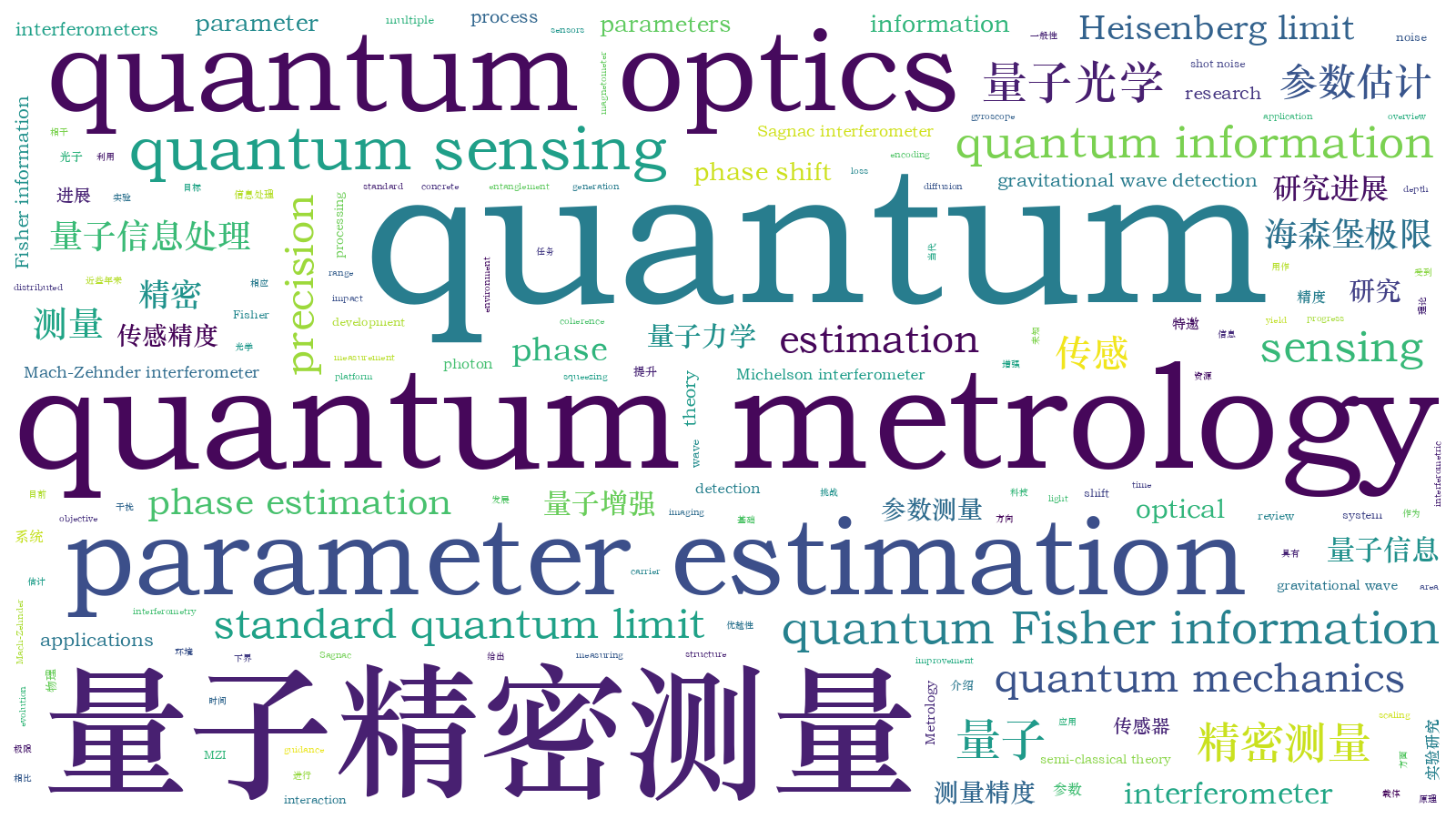光量子精密测量研究进展(特邀)  下载: 794次创刊五十周年特邀
下载: 794次创刊五十周年特邀
Quantum metrology, as one of the primary applications of contemporary quantum mechanics, has emerged as a crucial area of research in quantum technology in recent years. The fundamental objective of quantum metrology is to utilize quantum resources to enhance the precision of measuring unknown parameters in physical systems. Compared with other physical systems, photon-based systems possess distinct advantages such as long coherence time and low interaction with the environment, making them an ideal platform for processing quantum information. Improving sensing precision through photon-based sensors stands as a pivotal task within optical quantum metrology.
The general process of quantum metrology can be abstracted into four steps 1) preparation of a probe state; 2) interaction of the probe with the system to be measured; 3) measurement; 4) classical estimation, as shown in the main text (Fig.1). In terms of unitary evolution, Lloyd et al. compared the precision bound provided by four strategies, i.e., classical-classical (CC) strategy, classical-quantum (CQ) strategy, quantum-classical (QC) strategy and quantum-quantum (QQ) strategy (Fig.2). The QC and QQ strategies provide the ultimate precision of parameter estimation beyond the CQ and CC strategies. By analyzing the different strategies, one can easily find the relationships among the Fisher information, the QFI, the SQL and the HL (Table 1).
The fundamental theory of quantum metrology is based on the principles of parameter estimation theory. The quantum Cramér-Rao bound (QCRB) serves as a widely utilized mathematical tool in quantum metrology for evaluating the ultimate limit of precision. In the context of single parameter estimation, it is inversely proportional to the quantum Fisher information (QFI). By scrutinizing the QFI associated with different quantum states encoding parameters, one can determine which type of quantum states would be the most optimal for a given sensing task involving an unknown parameter.
The optical interferometer is a crucial apparatus in optics and plays an indispensable role in quantum metrology. Its applications range widely, from spectroscopic interferometric techniques to remarkable examples involving stellar interferometry and gravitational wave detection. Classical theory does not provide precise analysis of phase shift estimation in the interferometer, while the semi-classical theory, considering the quantized detection process, establishes the shot noise limit or standard quantum limit (SQL) of precision with N detected photons. However, it should be noted that SQL should not be considered as the fundamental bound when non-classical states of light, such as squeezed states, are injected into the interferometer. The maximally entangled photon number state known as NOON state can achieve a precision of 1/N referred to as the Heisenberg limit (HL). In comparison with SQL, HL exhibits scaling improvement and represents the fundamental bound for parameter estimation. Quantum resources like squeezing and entanglement can genuinely enhance phase estimation precision, while employing a sequential strategy where probe states undergo a sequential process can also yield maximal precision.
In recent years, quantum metrology has experienced rapid development, witnessing the generation of numerous non-classical quantum states with inherent metrological advantages and the invention of various interferometer structures aimed at enhancing phase estimation precision. Consequently, it is imperative to comprehensively and meticulously summarize existing research in order to provide guidance for future advancements in this field.
The fundamental principles of quantum metrology are elucidated, albeit in an abstract manner. To provide a more concrete illustration, we will consider the phase estimation problem as a prime example, which represents the most captivating application within quantum metrology. The Mach-Zehnder interferometer (MZI) serves as the prevailing structure (Fig.4). Numerous studies propose that by introducing distinct non-classical quantum states such as squeezed states and NOON states into the MZI, it is possible to enhance the estimation precision of phase shift in its two arms. Other types of interferometers like Michelson interferometer and Sagnac interferometer (Fig.6) also play significant roles in gravitational wave detection and quantum gyroscope applications. In practical scenarios, noise inevitably exists within interferometers. For instance, losses are almost unavoidable and can compromise precision levels. This review introduces several approaches aimed at mitigating the impact of loss.
In most realistic sensing scenarios, the system to be measured typically encompasses multiple unknown parameters. Multiparameter quantum metrology is also a crucial research aspect within the field of quantum information science, encompassing tasks such as estimating multiple phases, distributed quantum sensing, phase and phase diffusion, and so on. Besides addressing the phase estimation problem, optical quantum metrology finds numerous other applications including imaging and magnetometer. Finally, we provide a brief overview of some relevant works.
Photon, as an excellent information carrier, is suitable to be applied in quantum metrology, thereby establishing optical quantum metrology as a pivotal and burgeoning field of research. Further comprehensive and meticulous investigations are imperative to advance the theoretical and experimental development of optical quantum sensing. This review gives an in-depth and detailed introduction of recent progress in optical quantum process and we hope it will inspire some interest of readers.
王犇, 张利剑. 光量子精密测量研究进展(特邀)[J]. 中国激光, 2024, 51(1): 0112001. Ben Wang, Lijian Zhang. Progress in Photonics Quantum Metrology (Invited)[J]. Chinese Journal of Lasers, 2024, 51(1): 0112001.







